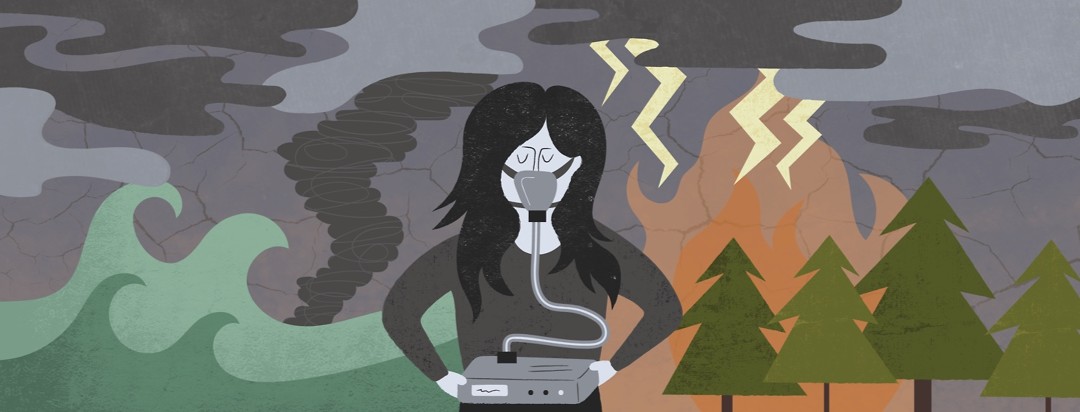Plan for Uninterrupted CPAP Usage During a Disaster
Three years ago, I participated in a national effort by the American Sleep Apnea Association (ASAA) to unite Hurricane Harvey victims with new continuous positive airway pressure (CPAP) machines. The folks fleeing the hurricane were forced to leave their CPAPs while evacuating.
Do you have a CPAP emergency plan? Here are my suggestions for planning ahead for an emergency situation. If you use PAP therapy to treat your obstructive sleep apnea (OSA), you can do a few things right now to protect your investment while preventing interruptions to your therapy.
3 ways to help yourself maintain your therapy
It’s not only possible but simple to set up PAP therapy ahead of an emergency. People who go tent camping or travel to remote places set up PAP so they don’t go without.
Why bother with even using PAP therapy during and following a natural disaster? For the same reason asthmatics carry spare inhalers and people with diabetes stash insulin supplies. You need your therapy every single night. Going without it risks your overall health and safety.
You may experience some potentially traumatic times if you’re stuck in a place where natural disaster damage is severe and help isn’t nearby. During such an intense period, sleep is more important than ever. It’ll keep you sane, energized, and able to make hard decisions. It'll also keep you alert while operating vehicles like cars or boats.
If you need to evacuate, don’t forget your PAP therapy. Even if you don’t have to evacuate, prepare to run out of electricity... maybe for a long time.
1. Have a second machine
Make sure you pack any spare you have in a “go bag.” Check that all the pieces are there, any batteries you need are charged, and it’s stored in an easy-to-access location so you don’t forget it during evacuation. Pack distilled water with it if you use the humidifier.
But how to get a second machine?
Refurbished equipment
Used (but safety-approved) machines can be acquired through a refurbished medical equipment supplier. Three organizations to approach are:
Spare equipment
If you still have an old machine you’ve replaced, and it’s still working (it may be louder than your spiffy new one, for instance), make that your spare. For people who have 2 or more homes (such as people working for the airlines or who travel extensively for work), a second machine may already be available. If you have a second machine, reclaiming it may be your best strategy if you live where disaster strikes.
New equipment
If you have the money, buy a second machine outright. Insurance companies may not reimburse you, but it’s worth asking about. You can also purchase a second CPAP with cash directly through your sleep specialist or an online CPAP supplier as long as you have an updated prescription. Some folks like the small CPAP machines designed for travel. They’re portable, easy to pack, and powerful enough to keep your OSA actively treated as long as you have access to electricity.
2. And speaking of electricity...
A PAP machine is useless without power.
Rig a power supply
Having a backup power supply can help you continue therapy during a disaster. Many CPAP forums offer creative tips for rigging to a marine or car battery. You’re best advised to visit the manufacturer of your particular PAP machine and see what they recommend. Manufacturers will give instructions for hooking up PAP to a car battery, free-standing marine battery, or portable battery backup. Follow their advice to prevent voiding the warranty.
Note: You may need an inverter that allows you to connect your existing machine to an auxiliary battery. Check your manufacturer to determine which inverter – or any other accessory – you’ll need.
Buy a battery backup
You can find backup batteries customized to your machine. They can be costly, but for some, it’s worth it. If you buy one:
- Check all the components as soon as it arrives to make sure you have all the parts you need.
- Charge it ahead of time, as necessary.
- Do a trial run – either before hurricane season hits or yearly – so you aren’t caught with equipment that doesn’t work.
3. Oral appliance, for the win?
Some people have oral appliances to treat their OSA. If you like this option and qualify for it – and it helps you with your sleep-breathing disorder – this may be the best option of all. It packs light, needs little maintenance, and doesn’t require electricity.
Interested in reading more tips on living well with CPAP? Explore our featured collection of tips and tricks for CPAP users.

Join the conversation